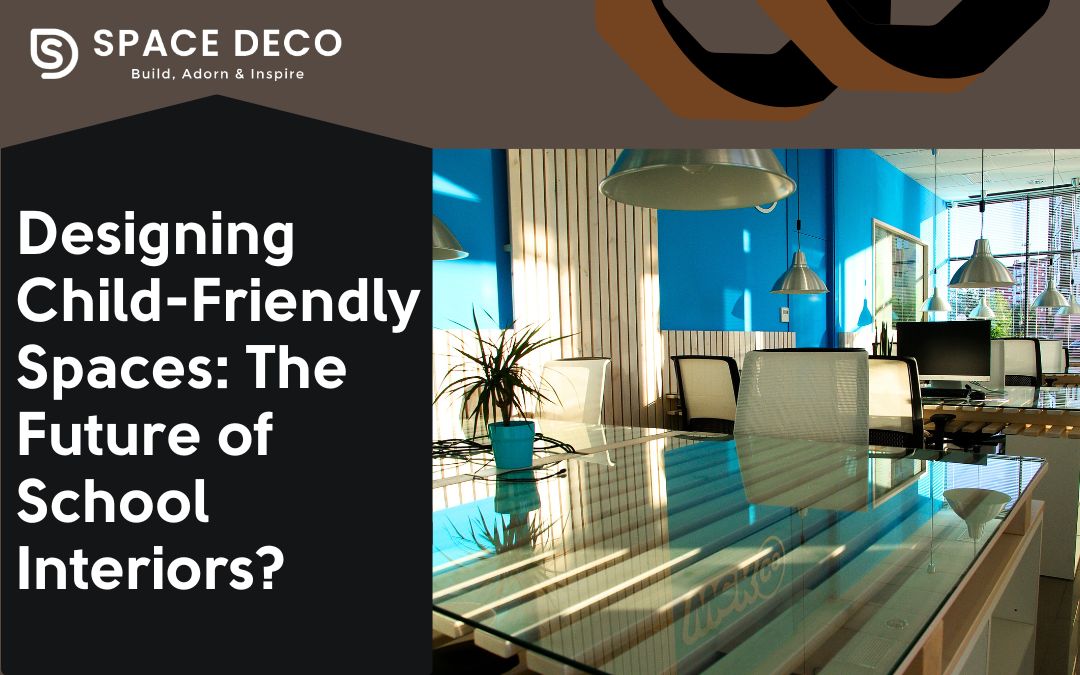In today’s rapidly evolving educational landscape, the physical environment of a school is just as important as its curriculum. Gone are the days of dull classrooms and one-size-fits-all designs. The future of education lies in designing child-friendly spaces, where creativity, comfort, and safety come together to foster learning. At Space Deco, we believe that smart school interiors should be more than just functional — they should be inspiring, inclusive, and future-ready.
Let’s explore how thoughtful interior design is shaping the next generation of learning environments and what makes a truly child-centric school space.
Why School Interiors Matter More Than Ever
A child spends a significant portion of their lives at school. The environment they study in can significantly influence their mental well-being, behavior, and academic performance. A well-designed, child-friendly space doesn’t just look good — it encourages engagement, supports focus, and builds a sense of safety and belonging.
Modern school interiors are shifting from rigid structures to flexible, imaginative, and student-centered designs. The future of school design focuses on holistic development — nurturing creativity, collaboration, and curiosity, right from the classroom layout to the choice of colors and materials.
What Makes a Space Child-Friendly?
Designing a child-friendly school interior requires more than adding bright colors or fun furniture. It’s about understanding the needs of children — physical, emotional, and developmental — and designing environments that support those needs.
Key Elements of Child-Friendly Design:
1.Safety First
- Rounded furniture edges, anti-slip flooring, non-toxic paints, and easy-to-reach emergency exits ensure children are safe at all times.
2.Comfortable & Ergonomic Furniture
- Kids grow fast, and so should their furniture. Adjustable desks, cushioned chairs, and relaxed seating areas reduce physical strain and enhance learning.
3.Playful, Purposeful Layouts
- Zones for learning, play, reading, collaboration, and relaxation help children thrive. Open layouts allow for movement and interaction, essential for young learners.
4.Natural Light & Ventilation
- Studies show that classrooms with ample daylight improve concentration and mood. Smart window placement and ventilation systems are key.
5.Color Psychology
- Colors affect mood and behavior. While blue can be calming, yellow sparks creativity. A thoughtful color palette can boost positivity and reduce anxiety.
6.Interactive Spaces
- Whiteboards, magnetic walls, reading pods, and maker zones turn walls and corners into interactive learning opportunities.
Technology Meets Design in Future Schools
Technology is an integral part of modern education, and its role in interior design is growing rapidly. Future-ready schools integrate smart boards, digital screens, charging stations, and VR zones within the design itself, rather than adding them as afterthoughts.
However, it’s not just about gadgets—it’s about seamlessly blending tech with physical space. For example:
- Modular desks with charging ports
- Walls that double up as projection screens
- Voice-controlled lighting or blinds for sensory comfort
At Space Deco, we design interiors that embrace innovation while keeping the child’s experience front and center.
Sustainability in School Design
As awareness around climate change grows, eco-friendly school interiors are no longer a luxury—they’re a responsibility. Sustainable design practices also teach children about environmental stewardship from a young age.
Green Design Tips:
- Use of recycled and non-toxic materials
- Solar-powered lighting systems
- Indoor plants for better air quality
- Rainwater harvesting systems
- Natural insulation to regulate temperatures
Sustainable design isn’t just planet-friendly—it also creates healthier learning environments.
Designing for Inclusivity
Every child is different. An inclusive classroom supports children with varying abilities, learning styles, and backgrounds. This includes:
- Quiet zones for neurodiverse students
- Braille signage for the visually impaired
- Wheelchair-accessible pathways and furniture
- Acoustically treated rooms for better hearing
Child-friendly design is inclusive by nature, ensuring no child is left behind — whether physically, emotionally, or socially.
The Role of Outdoor Spaces
Learning doesn’t end at the classroom door. Outdoor areas like gardens, open amphitheaters, and shaded reading corners are essential to the overall design of a child-friendly school.
By incorporating nature into school layouts, we promote physical activity, mindfulness, and a deeper connection to the environment.
Why Space Deco?
At Space Deco, we specialize in transforming traditional learning spaces into dynamic, future-focused environments. Our team collaborates with educators, psychologists, and architects to design interiors that are functional, inspiring, and age-appropriate.
We go beyond aesthetics to create spaces that ignite imagination, support growth, and encourage meaningful learning.
Whether you’re planning a new school or renovating an old one, we bring your vision to life with innovation, creativity, and care.
Designing child-friendly spaces is not just about making classrooms look fun—it’s about creating environments that empower children to explore, imagine, and thrive. The future of school interiors is inclusive, interactive, and innovative.
As we move forward, the classroom must evolve from a space of passive learning to a dynamic hub of discovery and engagement. With thoughtful design, schools can become more than institutions — they become second homes where children feel safe, inspired, and ready to grow.
Let Space Deco guide you in designing school interiors that are truly built for the future — one child, one classroom, one space at a time.

